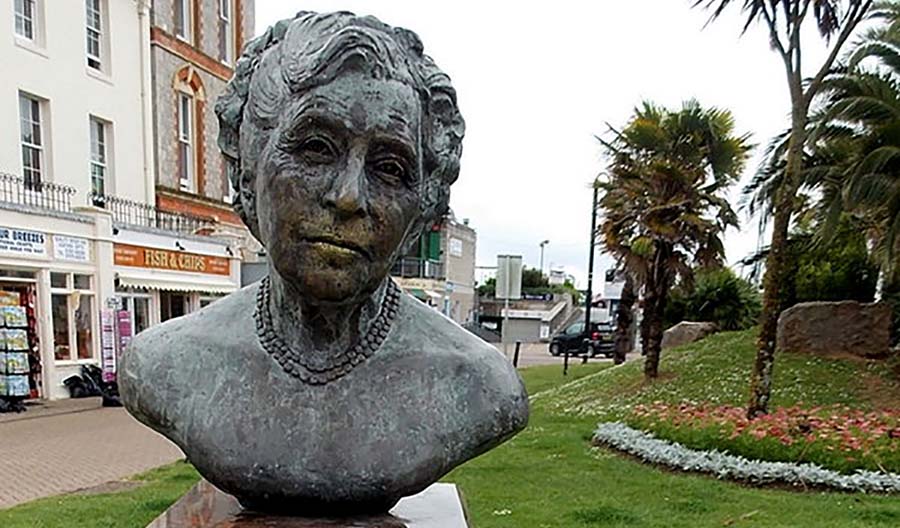
Identifying Locations in Her Novels
by Maureen Vincent-Northam
It’s hard to imagine Devon as the inspiration for murder. This rural county, the fourth largest in England, is better known to most for its rolling hills and Devonshire cream teas. But no fewer than fifteen of Agatha Christie’s crime novels are set in Devon, or have specific connections with the county.
Agatha Mary Clarissa, the youngest of three children, was born to Frederick and Clara Miller in the coastal town of Torquay in 1890. This part of South Devon is known as the English Riviera and the town’s pride in its most famous daughter is evident from the sign-posted ‘Agatha Christie Mile’, a walking tour which takes in some of the places which inspired the author. Close to the Tourist Centre is the only sculpture of Agatha Christie on view in the world. The bronze bust was unveiled on September 15th, 1990 by her daughter, Mrs Rosalind Hicks, to commemorate the centenary of Agatha’s birth.
A short distance away is Princess Gardens, where Agatha was a frequent visitor. The Princess in question was Louise, one of Queen Victoria’s children. The gardens, opened in 1894, are laid out in a classic Victorian design with palm trees, cast-iron ornamental fountains, and shelters.

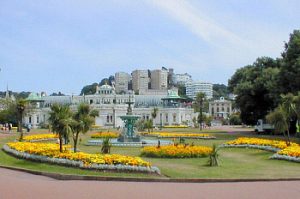 If you make your way around the harbour to Victoria Parade and begin to climb Beacon Hill, you’ll come upon The Imperial Hotel. Built in 1866, it boasts stunning views over Torbay and was Torquay’s first large ‘fashionable’ hotel, where Agatha herself attended social events. The list of distinguished former guests is quite impressive: King Edward VII, Lily Langtry, Emperor Napoleon III, Miss Jane Marple and Hercule Poirot.
If you make your way around the harbour to Victoria Parade and begin to climb Beacon Hill, you’ll come upon The Imperial Hotel. Built in 1866, it boasts stunning views over Torbay and was Torquay’s first large ‘fashionable’ hotel, where Agatha herself attended social events. The list of distinguished former guests is quite impressive: King Edward VII, Lily Langtry, Emperor Napoleon III, Miss Jane Marple and Hercule Poirot.
The Imperial Hotel appears in three of Agatha’s crime novels. In the opening chapter of Peril at End House (1932) it has been renamed the Majestic, and Torquay too has a new – though easily recognisable – identity. Captain Hastings tells us: We were sitting on one of the terraces of the Majestic Hotel. It is the biggest hotel in St. Loo and stands in its own grounds on a headland overlooking the sea. Soon, a would-be murderer makes a grave mistake when he takes a pot shot at his victim while she is talking with Hercule Poirot!
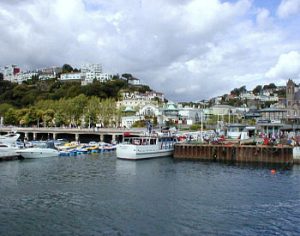 In The Body in the Library (1942), a murder victim is found in the library belonging to Arthur and Dolly Bantry. Help is at hand from Dolly’s friend, Jane Marple, and the ladies check in to the Majestic (now situated in fictional Danemouth) to conduct some investigations of their own.
In The Body in the Library (1942), a murder victim is found in the library belonging to Arthur and Dolly Bantry. Help is at hand from Dolly’s friend, Jane Marple, and the ladies check in to the Majestic (now situated in fictional Danemouth) to conduct some investigations of their own.
Sleeping Murder (1976) is the third book to feature The Imperial Hotel – this time as itself. In the final chapter, ‘Postscript at Torquay’, Miss Marple takes to the terrace with Gwenda and Giles Reed and sheds light on a mystery that has escaped detection for 18 years.
Kents Cavern, the oldest Scheduled Ancient Monument in Britain, is one of Torquay’s major tourist attractions and appears as Hampsly Cavern in The Man in the Brown Suit (1924), one of Agatha’s earliest novels. Agatha herself was later to develop a great interest in archaeology and travel widely with her second husband, archaeologist Max Mallowan.
Agatha was baptised at All Saints Church, Torre, in Devon. Her father, having gifted money to the church, ensured his daughter’s entry as a ‘founder member’. A short walk from here is the old Vicarage, Newton Road – now the Heathcliff Hotel. Tea at the Vicarage seemed a fairly frequent event for the Miller family, so it’s not surprising that Agatha sought advice from family friend, the Reverend Harold Petty on ecclesiastical matters when she was writing The Murder at the Vicarage (1930). St Mary Mead is the fictional location, Colonel Protheroe the ill-fated victim, but Agatha’s new sleuth, Miss Marple, ably assists the vicar, Leonard Clement, to solve the mystery.
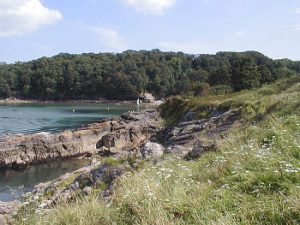 Broadsands lies about halfway between Paignton and Brixham. From the car park, Elberry Cove is a ten-minute walk along the coastal path. At one end of the beach are the remains of a Victorian Bath House, looking a bit like a small castle.
Broadsands lies about halfway between Paignton and Brixham. From the car park, Elberry Cove is a ten-minute walk along the coastal path. At one end of the beach are the remains of a Victorian Bath House, looking a bit like a small castle.
This peaceful and unspoilt location couldn’t possibly be the scene of a murder, could it? Actually, yes, whilst taking his evening stroll in the field overlooking the cove (Elbury in the novel), Sir Carmichael Clarke receives a crashing blow to the back of his head. His body is discovered at a spot near the hedge, halfway across the field – another unfortunate victim in The ABC Murders.
Throughout her writing life, Agatha gave many of her books and stories to family and friends. “Something between a book and a short story” is how Agatha describes the work she donated to the Church of St Mary the Virgin in the village of Churston Ferrers, which she attended frequently during the years she lived at Greenway House. The proceeds of the work were to put in place a stained glass window to replace a plain one, which Agatha claimed, “Gaped at me like a gap in teeth.” The finished window is in mauve and green, Agatha’s favourite colours, and depicts Jesus as the Good Shepherd.
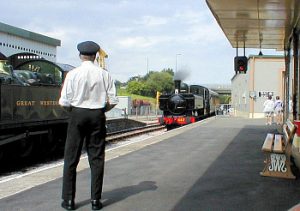 The Paignton and Dartmouth Steam Railway runs along a seven-mile scenic route from Paignton to Kingswear. Along the way it stops at Churston Station where Agatha boarded the train on many occasions. The Churston Volunteer Group now maintains the station and during peak holiday season there’s a regular steam train service.
The Paignton and Dartmouth Steam Railway runs along a seven-mile scenic route from Paignton to Kingswear. Along the way it stops at Churston Station where Agatha boarded the train on many occasions. The Churston Volunteer Group now maintains the station and during peak holiday season there’s a regular steam train service.
Hercule Poirot and Captain Hastings also travelled along the route in The ABC Murders, where the station appears under its own name. A note from the killer warns Poirot of an impending murder at ‘Churston on the 30th’, but the letter has been wrongly addressed; will the indomitable detective get to Churston in time?
Agatha renames the station ‘Nassecombe’ in Dead Man’s Folly (1956). In the opening chapter, at the urgent request of detective novelist Ariadne Oliver, Poirot takes the twelve o’clock train from Paddington to Nassecombe Station. Mrs Oliver has been hired to organize a Murder Hunt at a garden party hosted by Sir George and Lady Stubbs and she has a hunch that something is amiss!
Galmpton, the closest village to Greenway House, is easily recognizable as Nassecombe village, where Poirot speaks with the parents of the murder victim in Dead Man’s Folly.
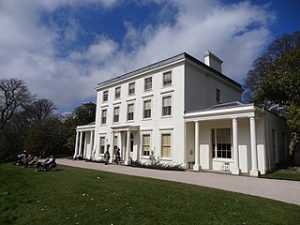 In 1938, Agatha purchased Greenway House, a Georgian property set on land beside the River Dart. The property became the residence of her daughter Mrs Rosalind Hicks until her death in 2004. It has since passed to The National Trust with Agatha’s grandson, Mathew Prichard, gifting the house’s collections and interiors. The Trust will undertake a major restoration project before opening the house to the public, but Greenway Gardens, also part of the National Trust, are open to visitors.
In 1938, Agatha purchased Greenway House, a Georgian property set on land beside the River Dart. The property became the residence of her daughter Mrs Rosalind Hicks until her death in 2004. It has since passed to The National Trust with Agatha’s grandson, Mathew Prichard, gifting the house’s collections and interiors. The Trust will undertake a major restoration project before opening the house to the public, but Greenway Gardens, also part of the National Trust, are open to visitors.
Greenway becomes Nasse House in Dead Man’s Folly. The grounds are to be the setting for Mrs Oliver’s Murder Hunt and it isn’t long before a real victim is found in the boathouse.
The twisting road past the gates of Greenway House leads to Greenway Quay. Poirot, ‘in a mood of exploration’ takes off down this road and finds himself on the small quay. Here he discovers a large bell with a chain and a notice that reads ‘Ring for the Ferry’. Across the river lies the village of Dittisham (re-named Gitcham in Dead Man’s Folly), which can be reached by the passenger ferry.
Greenway Quay’s bell was also used in the opening of Ordeal by Innocence (1958), when Dr Calgary rings it to summon the ferryboat. The bell is still in use on the quay today.
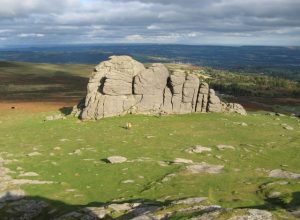 Agatha completed her first novel, The Mysterious Affair at Styles (1920), at the Moorland Hotel at Hay Tor on Dartmoor. During World War I, while working as a Voluntary Aid Detachment nurse in Torquay’s Red Cross Hospital, she had been challenged by her sister, Madge, to write a crime story. Later, when Agatha had completed the examination of the Society of Apothecaries of London and qualified as a pharmaceutical dispenser, she took up her sister’s challenge.
Agatha completed her first novel, The Mysterious Affair at Styles (1920), at the Moorland Hotel at Hay Tor on Dartmoor. During World War I, while working as a Voluntary Aid Detachment nurse in Torquay’s Red Cross Hospital, she had been challenged by her sister, Madge, to write a crime story. Later, when Agatha had completed the examination of the Society of Apothecaries of London and qualified as a pharmaceutical dispenser, she took up her sister’s challenge.
Being surrounded daily by poisons, it wasn’t too surprising that Agatha would choose this method of murder in her debut novel. The Mysterious Affair at Styles also marked the first appearance of Hercule Poirot, who was to grace a further thirty-six books over the following fifty years.
Agatha chose a Dartmoor setting for at least two of her novels: Poirot and Hastings head for the fictional village of Hoppaton to conduct investigations in The Big Four (1927) – the first book produced after the break-up of Agatha’s marriage to Archie Christie. Sittaford, another fictional Dartmoor village, is cut off by several feet of snow in Agatha’s fourteenth novel, The Sittaford Mystery (1931), where a seance takes place at Sittaford House.
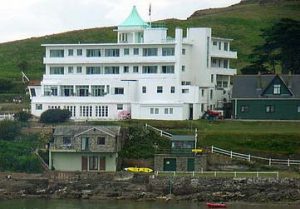 Burgh Island, once owned by millionaire Archibald Nettlefold, was used in two of Agatha’s books. The island is cut off twice a day by the tide, but at low tide it is possible to walk across from nearby Bigbury-on-Sea.
Burgh Island, once owned by millionaire Archibald Nettlefold, was used in two of Agatha’s books. The island is cut off twice a day by the tide, but at low tide it is possible to walk across from nearby Bigbury-on-Sea.
In Evil Under the Sun (1941), this location becomes Smugglers Island in Leathercombe Bay and the hotel is The Jolly Roger. Hercule Poirot, in common with the other guests, has come here to relax, but with the arrival of Arlena Marshall comes jealousy, blackmail and murder.
And Then There Were None (1939) – originally called Ten Little N*ggers in the UK and Ten Little Indians in the US – is often considered Agatha’s most ingenious plot. Ten people, all with something to hide, are invited to stay on the island. One by one they are murdered, until no one is left alive.
The idea of writing such an impossible mystery so fascinated Agatha that she saw it as her most difficult challenge. It is fitting that Burgh Island, one of Agatha’s favourite locations, should be the setting for the novel she considered her greatest achievement.
© Maureen Vincent-Northam 2008
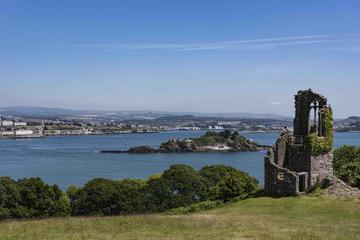
Bespoke Tour of Devon and Cornwall from Devon or Cornwall
If You Go:
Torquay Museum
529 Babbacombe Road, Torquay TQ1 1HG
01803 293975
www.torquaymuseum.org
Email: enquiries@torquaymuseum.org
Torquay Museum has the Agatha Christie Collection which includes photographic material, much of which has not been published elsewhere. There are displays featuring films and TV series based on her novels with costumes and other items.
Torre Abbey
The King’s Drive, Torquay TQ2 5JE
01803 201201
www.torre-abbey.org.uk
Email: torre-abbey@torbay.gov.uk
Torre Abbey contains the Agatha Christie Memorial Room which features her favourite armchair, her typewriter, and her plotting book containing the handwritten manuscript of ‘A Caribbean Mystery’
Greenway Gardens
Greenway Road, Galmpton Devon TQ5 0ES
01803 842382
www.nationaltrust.org.uk
Email: greenway@nationaltrust.org.uk
Greenway Gardens have been open to the public since 2000, and the National Trust hope to complete restoration work to the house and have it opened to visitors by 2009.
Paignton and Dartmouth Steam Railway
Dart Valley Railway, Queen’s Park Station, Torbay Road,, Paignton TQ4 6AF
01803 555872
Kents Cavern
Cavern House, 89/91 Ilsham Road, Torquay, TQ1 2JF
01803 215136
Email: caves@kents-cavern.co.uk
Torquay Tourist Information Centre
Vaughan Parade, Torquay, TQ2 5JG
01803 297428
Email: torquay.tic@torbay.gov.uk
About the author:
Maureen Vincent-Northam has been published in newspapers, magazines and on the Web. She is the co-author of The ABC Checklist for New Writers and the author of The Greatest Genealogy Tips in the World, having worked as a family history researcher for many years. www.maureen-vincent-northam.co.uk
Photo credits:
Agatha Christie statue in Torquay: Jaggery / Agatha Christie statue in Torquay
Greenway House: MANHATTAN RESEARCH INC (MANHATTAN RESEARCH INC) from MANHATTAN RESEARCH INC , MANHATTAN RESEARCH INC / CC BY
Hay Tor, Dartmoor: Nigel Cox / Dartmoor: Haytor Rocks
Burgh Island Hotel on Burgh Island: didbygraham / CC BY
All other photos by by Maureen Vincent-Northam
